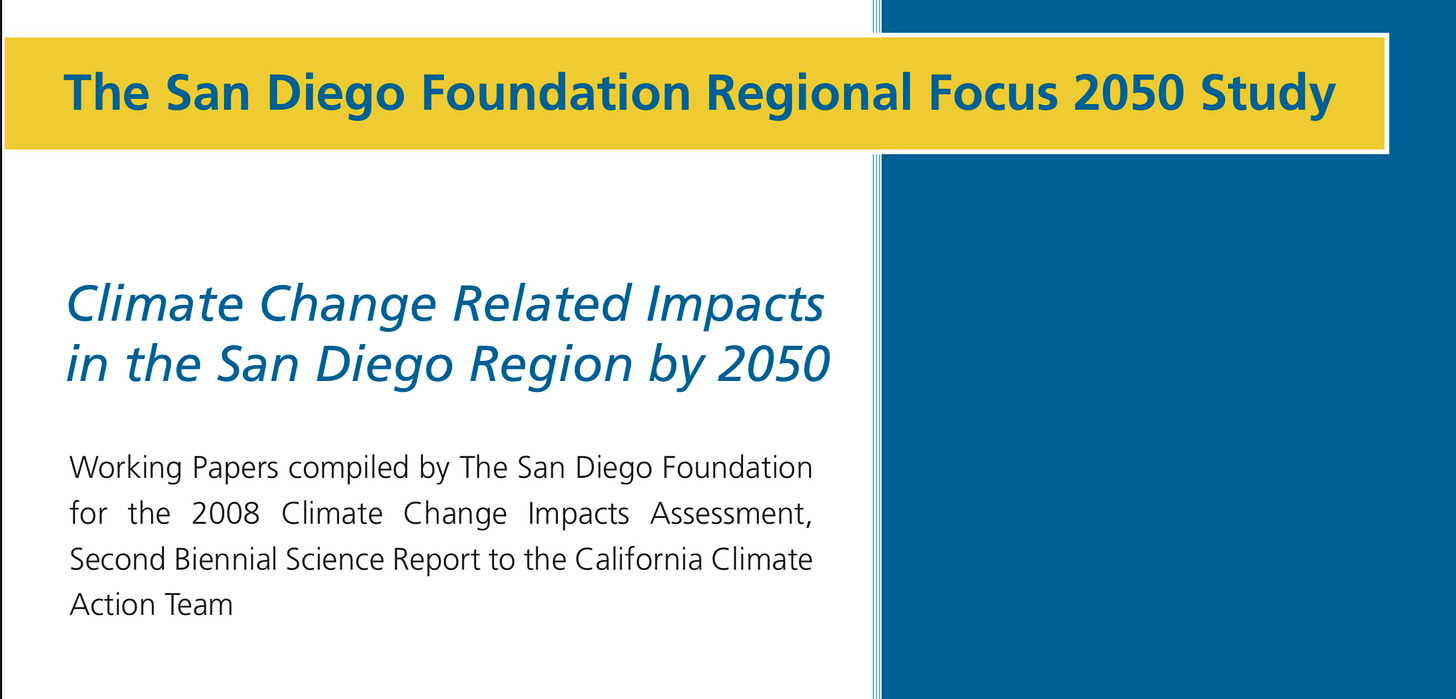“This scientific study considers the regional impacts due to climate change that can be expected by 2050, if current trends continue. Higher temperatures, changing precipitation, and a rising sea level will create new issues that will require considerable planning and coordination, as well as exacerbate existing stresses. The extent to which these impacts from climate change affect local communities will depend not only on our ability to change current trends and reduce regional emissions, but also on careful planning in the face of the most serious vulnerabilities.”
My first “big presentation” as a new member of the Director’s staff at UCSD’s Scripps Institution of Oceanography was to a large Southern California law firm with its name atop a skyscraper in downtown San Diego.
I felt a bit like a fish out of water when I arrived at Scripps from the large multi-strategy hedge fund in Chicago where I led a quantitative research team linking weather to energy trading. UCSD recruited me to La Jolla to develop an initiative to link basic science to commercial applications.
Procopio, the law firm that was audience to my first big presentation of Scripps science, has a well-established reputation in environmental and climate-change practice and was a major supporter of Scripps. So, it was a friendly audience.
I crafted my presentation from a newly published study at the time, The San Diego Foundation Regional Focus 2050 Study: Working Papers for the 2008 Climate Change Impacts Assessment, Second Biennial Science Report to the California Climate Action Team. San Diego, California. I felt quite confident that I could accurately represent the material because of my background as a meteorologist with a law degree.
Climate change for lawyers … right up my alley!
I joined Scripps after a decade as a weather-communicator. My career included work for television and radio stations around the country, including a series of “special reports” on climate change for WOR Radio in New York City in response to the Second Assessment Report of the Intergovernmental Panel on Climate Change.
I’ve got this!
As I set up for my presentation in the large and comfortable conference room at Procopio’s penthouse office in San Diego’s Financial District, I was feeling quite confident. Coincidentally, this was the first week for a summer intern that was working in my office. The Stanford undergraduate was eager to see how public sector climate change science intersected with private sector law practice and I invited him along to watch the presentation.
It went something like this:
My presentation ran about 43-minutes longer and 50 additional slides versus that introduction video. That said, you’ve seen enough to get the idea.
On the drive back to La Jolla, I asked my nineteen-year-old intern what he thought. I expected he’d be full of praise and figured he’d gush about everything he’d learned during that hour at Procopio.
As a side-note, this hotshot kid from Stanford would go on to get an MBA from Harvard Business School and now -15 years later- runs his own investment firm after starting several companies of his own.
He didn’t hesitate to speak up and, from the passenger seat of my Honda Civic as we headed north on The Five, he said:
“It was fine but it could have been a lot better.”
He bluntly told me that I had failed to capture his attention. He told me how he had “drifted in and out” as the slides went by. He watched the faces of the lawyers in the room who silently stared out the window as they sipped coffee and munched cookies during that hour in the sky-lounge conference room. He was pretty sure that I had failed to inspire them.
He went on to ask me, “Have you ever read Made to Stick?”
It’s easy to give a presentation and fail to inspire…
Have you ever given a presentation that “fell flat” for your audience? Share your experience with us…





During my Peace Corps service in Mexico, I gave a series of presentations in a community to support them on what they wanted to address not having access to piped water. One presentation was about climate change scenarios that I ran and how that would impact their annual rainfall. I thought I had simplified the graphs but I think graphs weren’t the appropriate way to present that information to this audience. The community members were to nice to say anything but I could see it on their faces like what is this gringa talking about.
I once worked for an environmental education non-profit where I was given a canned lesson plan to teach and told not to deviate from it. The day's lesson was marine mammals which I had introduced many times and had success with in the past. It was fun and hands-on and included several props for the kids to engage with. As I revealed the specimens and pictures to the students, I was met with expressionless faces. I also noticed a couple of students had fallen asleep. I struggled through most of the lesson before one student interrupted me to say they had spent the last two weeks studying marine mammals and that they "knew it all already." It's essential to understand your audience and to be able to pivot and tailor your message to them!